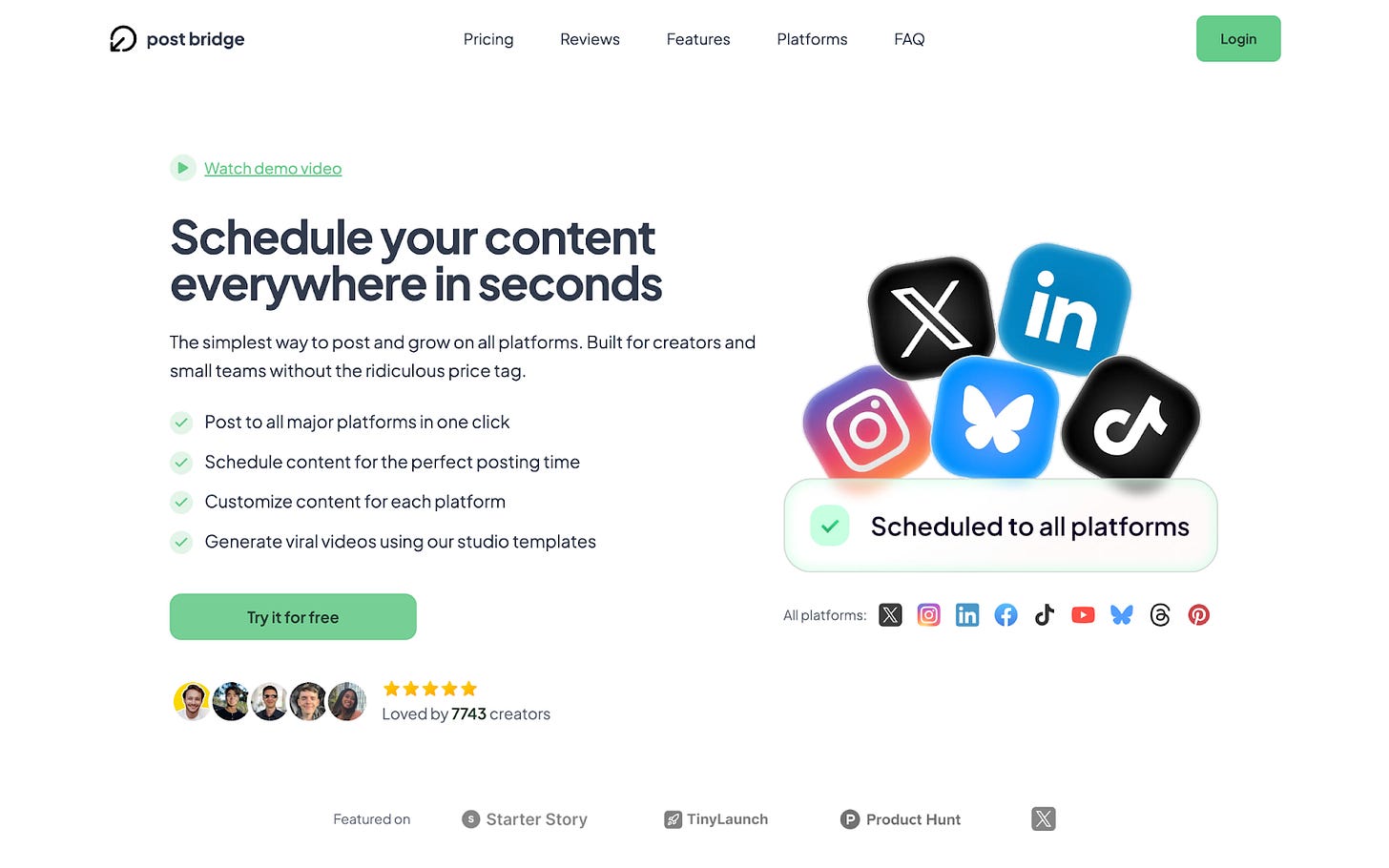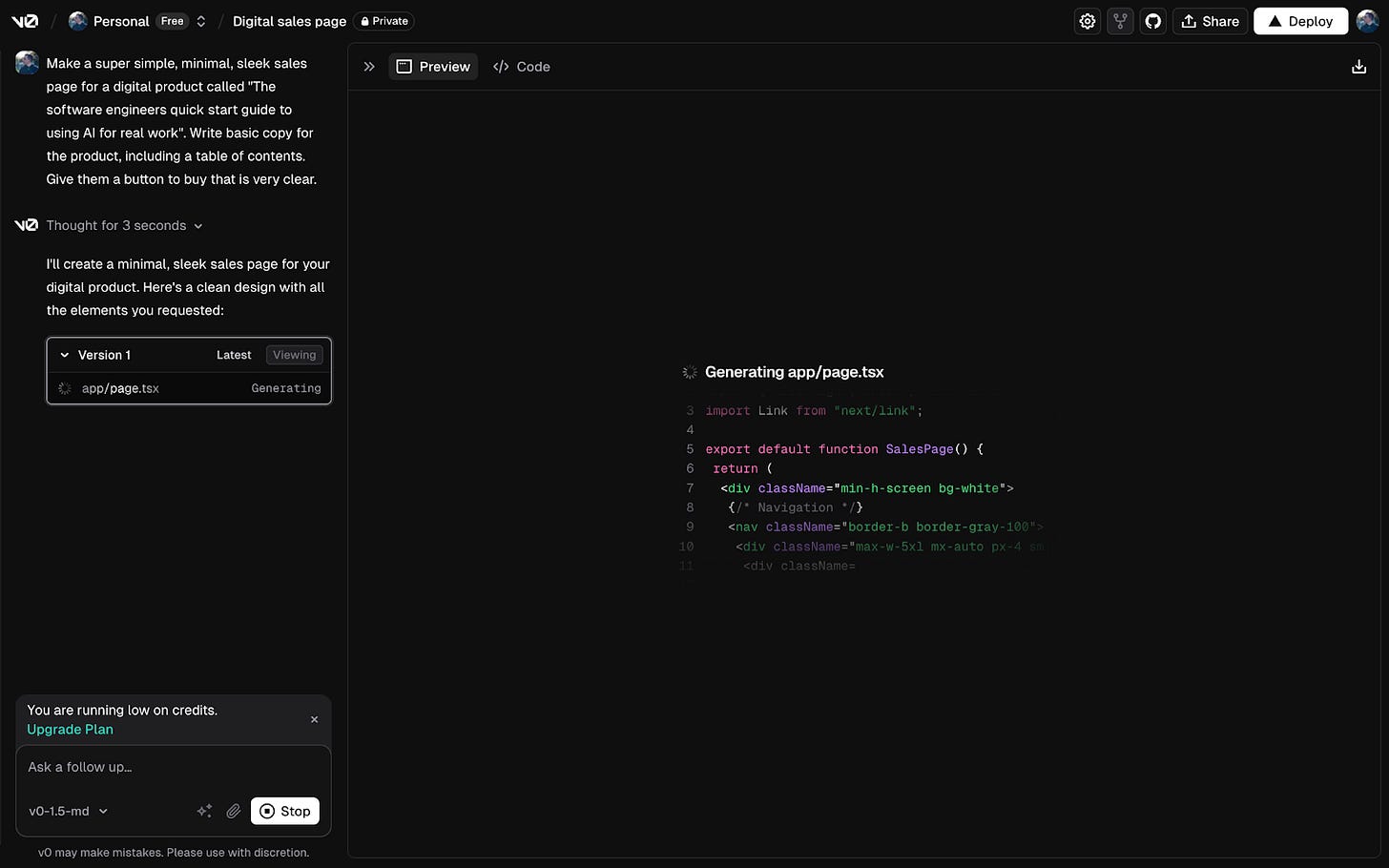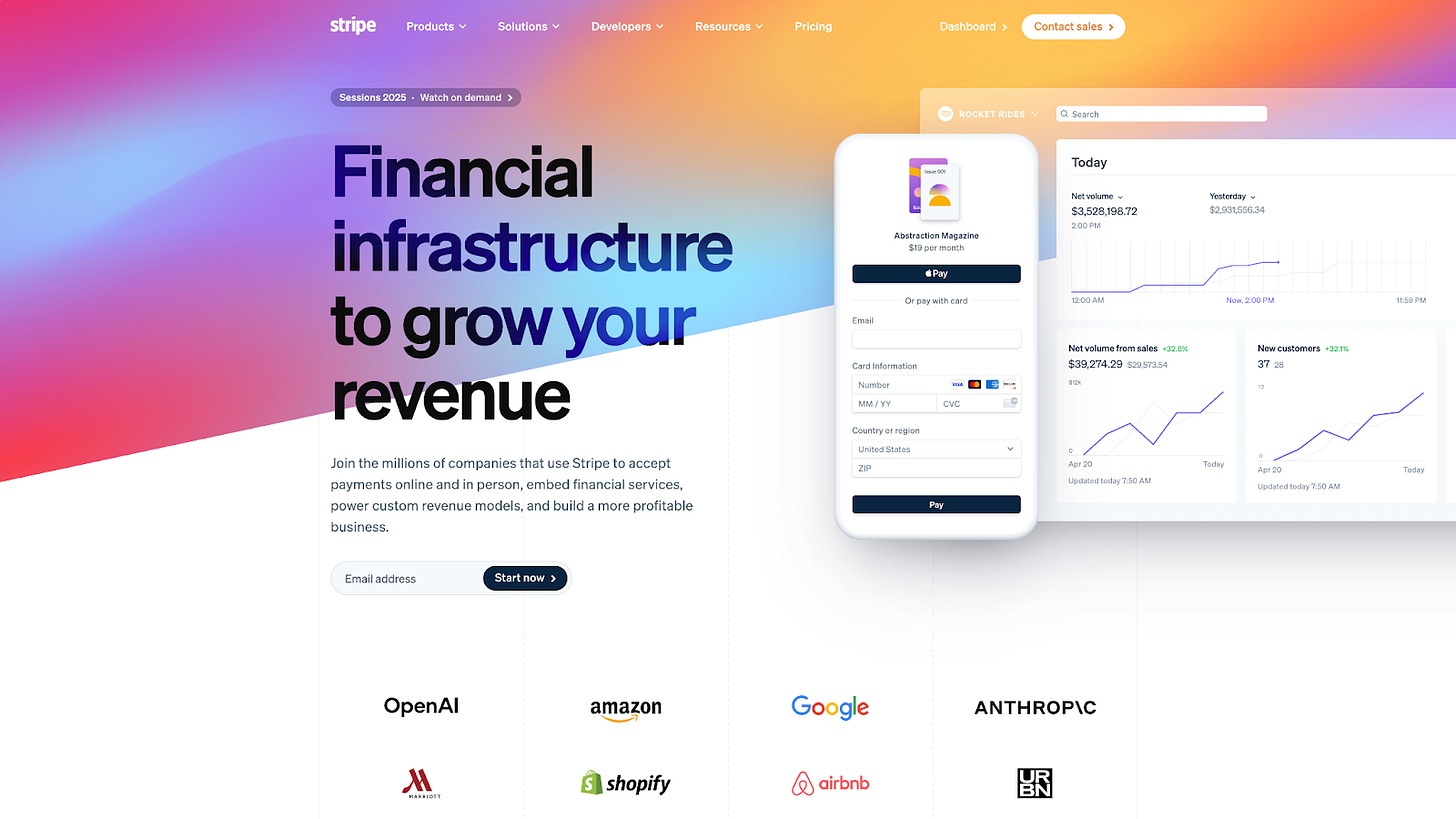Vibe Coding Best Practices: How to Build Fast Without Breaking Everything
A practical guide for marketers, creators, and solopreneurs using AI to ship real products safely—written by a software engineer.
Hey, I’m Casandra. I share really good business ideas to help you start and grow a business. Welcome to a very special ✨ free edition ✨ of my newsletter!
Subscribe for weekly insights that help you start smarter and scale faster.
You don’t need to know how to code to build software anymore.
Thanks to tools like v0, Replit, and Cursor, anyone with a good idea and a half-decent prompt can spin up a landing page, prototype a tool, or even launch a micro-SaaS with zero technical background.
It’s fast, it’s fun, and it’s totally changing how digital products get made.
But here’s the thing: just because you can build something doesn’t mean you’ll build it right. And if you’re not careful, it’s easy to end up with a broken app, exposed data, or a surprise cloud bill that makes you rethink the whole thing.
So, I asked Jeff Morhous 🦾, a seasoned software engineer and the author of The Augmented Engineer, to break it down for us.
Below, he shares the vibe coding best practices you actually need to know—especially if you’re a marketer, creator, or solopreneur using AI tools to build your first product.
Vibe Coding Best Practices: How to Build Fast Without Breaking Everything
If you’ve spent any amount of time online in the last few years, you’re probably already familiar with how quickly AI tools are changing work. One of the biggest changes is what it looks like to make software. AI-augmented software development unlocks tons of opportunities—and not just for software engineers!
Sure, using AI tools to write code changes the game for software engineers like me, but it doesn’t stop there.
Tons of people with no coding experience at all are using AI tools to build software that makes them money. Many online are calling this vibe coding because the focus has quickly shifted from writing code to building products.
Sometimes, it’s just people scratching their own itch, making software that helps them. Other times, it’s people making full-on SaaS products that they sell to their audience.
Take Jack Fricks, for example. With no coding experience, he built a handful of applications, including one that received an acquisition offer for one million dollars!

We are at a unique window in time where it’s never been easier to write software for your business. Still, vibe coding might be a little daunting if you’re not a software engineer.
But that shouldn’t stop you!
Today, I’m going to walk you through how to get started with some of the best AI tools while staying safe.
Getting Started With Vibe Coding
AI coding tools fall into one of two major categories. The first is AI-assisted code editors, like Cursor or Windsurf. These tools are popular among software engineers, but not as useful for complete newcomers.
If you’re just looking to get a visual application onto the internet, you’re probably going to have the most luck with Loveable, Bolt, or v0.
Among these, my favorite choice to quickly prototype software products is v0.

This is where things really get fun. For our example, I’ve been itching to make a landing page for a digital product I’m working on. Here’s the prompt I started with:
Make a super simple, minimal, sleek sales page for a digital product called "The software engineers quick start guide to using AI for real work". Write basic copy for the product, including a table of contents. Give them a button to buy that is very clear..V0 will do some reasoning and then kick off the project.

Within 5 minutes, v0 had a prototype that I was already pretty happy with.
Now, what about getting our project on the internet?
Getting Your AI-Coded Project Online
The great thing about using v0 is that all you have to do to get your project on the web is click “Deploy”. In less than ten minutes since I started, the sales page is already on the internet!
The “Buy Now” button doesn’t go anywhere yet, but we’ll get to that later when we talk about payments and Stripe.
So what’s happening under the hood here? V0’s deploy button sets your project up on Vercel, a popular platform for hosting web applications. You can, of course, set up your own server, but using a platform like Vercel abstracts away much of the hassle and risk of running your own infrastructure.
If you’re following along, you’ll probably notice the web address (aka “domain”) of your project is a little weird. Fear not! Vercel allows you to use a custom domain from any domain provider for your project after you get it running.
How to Stay Safe While Vibe Coding
Just because you can write code with AI doesn’t mean everything you produce will be safe. Software engineering is a complicated profession full of pitfalls and gotchas, so you should exercise some caution when working on projects.
Next, I’ll walk you through some pitfalls to avoid while you’re working with AI to make web projects. While this can’t be an exhaustive list, keeping these things in mind will seriously reduce your surface area for risk.
Static Sites Are Safest
The first thing to keep in mind is that static sites are generally the safest option.
Static sites are sites whose content doesn’t change. The sales page we built above is a great example of a static page. It doesn’t handle user input, user profiles, storing data, or payments, so there’s not too much that can go wrong! If you don’t want to handle some of these things, be sure to read the next section for things to keep in mind.
Make Sure Your Secrets Are Secure
Another thing to keep in mind is to always secure your secrets. As your applications get more complicated, you’ll eventually come across things like API keys that should stay “secret”.
There are two major ways to keep your secrets safe.
The first is to never put secrets in code that shows on the user's browser.
The second is to use environment variables to store secrets rather than keeping them in your codebase.
Following these two rules significantly reduces the risk that these secrets fall into the hands of a bad actor. If you are wondering if you secured your secrets, ask your coding tool if there’s anything in the codebase that should be secret!
Set Budgets for Your Platform Vendor
One thing to keep in mind for costs is to set budgets for your platform vendor. Whether you’re using Vercel (the default for v0) or another platform, setting a budget will help you avoid unexpected costs. The free tiers on these platforms are quite generous, so I have a $1/mo budget and never run up against it.
Set Up Rate Limiting or Throttling on Your Application
A more advanced technique to protect against bad actors is to set up rate limiting or throttling on your application. This prevents a single actor from using your application fast enough to cause a “Denial of Service” problem,1 which protects you from outages and unexpected costs. Rate limiting is a pretty complicated topic to cover in detail, but you can get a good start with your platform’s tools built specifically for this!
Sanitize Input from Users
If you’re making an interactive application that stores information from the user, be sure to sanitize any input from users. This protects you from “SQL injections,” a common hack that can corrupt or expose your stored data.
Most modern frameworks (like Next.js, which is what v0 uses) make this pretty easy. If you’re storing user input, just look up “SQL sanitization” in your framework’s documentation. If you’re having a hard time, don’t be afraid to ask your agentic coding tool for help and even pass along the documentation.
Note: If techniques like input sanitization, rate limiting, and environment variables are scaring you off and you’re not comfortable with the solutions your AI tool is providing, then stay in the realm of static sites! Being able to make static sites with near-infinite customization at no cost is a huge unlock for internet solopreneurs.
Use Vendors for Risky Things
Because AI lets you write so much software so quickly, you may be tempted to write logic that a third-party vendor might be better suited for. Here are a few examples.
Stripe Payments for Payments
You could try to handle payments on your own, but it's much safer and easier to use a vendor like Stripe to handle payments for you. Stripe will process the payment for you, and your application will never have access to the users’ payment details, making it impossible to have a data breach.

Stripe has made payments super easy with payment links, their all-in-one solution. Payment links are mostly no-code, but you can lean on your AI tool to help you insert the actual link into an appropriate button or link on your website.
Supabase for Database Hosting
If you really want to persist some data from users, you will need a database. This can get pretty complicated, so consider using a managed database service like Supabase to host your database. This abstracts away many database pitfalls and keeps your data safer. Supabase will provide you with links and clear instructions on how to send data to and from the database using API calls, which your coding tool can help you set up.
Still, working with a database means you have the responsibility of keeping your data safe. You’ll need to protect against a whole host of new potential security vulnerabilities, like horizontal escalation and SQL injection. You effectively mitigate these, particularly by using good resources like the OWASP Top Ten with your AI tools, but be sure to be extra vigilant.
Clerk for User Authentication
If you want users to have accounts, consider using an authentication provider like Clerk to store the authentication information, which takes away another risk vector. Clerk has good documentation for getting started, and this route can be done without storing much data.
Go Out and Build Something!
Vibe coding is more than just a fun trend. It’s a name for a new era. You no longer need permission or an experienced team to put together a website. Of course, software engineering isn’t going away. The more dynamic and useful you want your app to be, the more you’ll need some technical experience.
If you want to be in the loop on how you can use these AI tools to make apps and websites, check out The Augmented Engineer. There’s plenty of useful content here, and this article is a great place to start.
A huge thank you to Jeff Morhous 🦾 for sharing all this insight!
Be sure to check out The Augmented Engineer for more for more great tips and information, especially if you’re interested in learning more about AI-supported software development.
I hope this post made you feel a little more confident (and maybe even a little excited) about building with AI. You don’t have to be a developer to create something useful, beautiful, and profitable. But a little bit of technical wisdom can go a long way toward avoiding dangerous and costly mistakes.
And when you do end up building something, please share in the comments! I’d love to see what you’re working on.
To endless possibilities,
Casandra
Can you do me a favor? If you found this useful, tap the ❤️ below. It’ll help me and Jeff out a lot!







Thanks for the breakdown. Security is such a crazy issue now. And with so much data out there you'd think your's is not relevant. I'd say that building smart is a faster way to a million dollar sale though.
Thanks for this ! The pointers on which security tools to use is right on. Thank you !